Butterfly babies: The worst disease you've never heard of
A rare disease makes these young girls’ skin break and peel at the slightest touch, like a butterfly’s wings
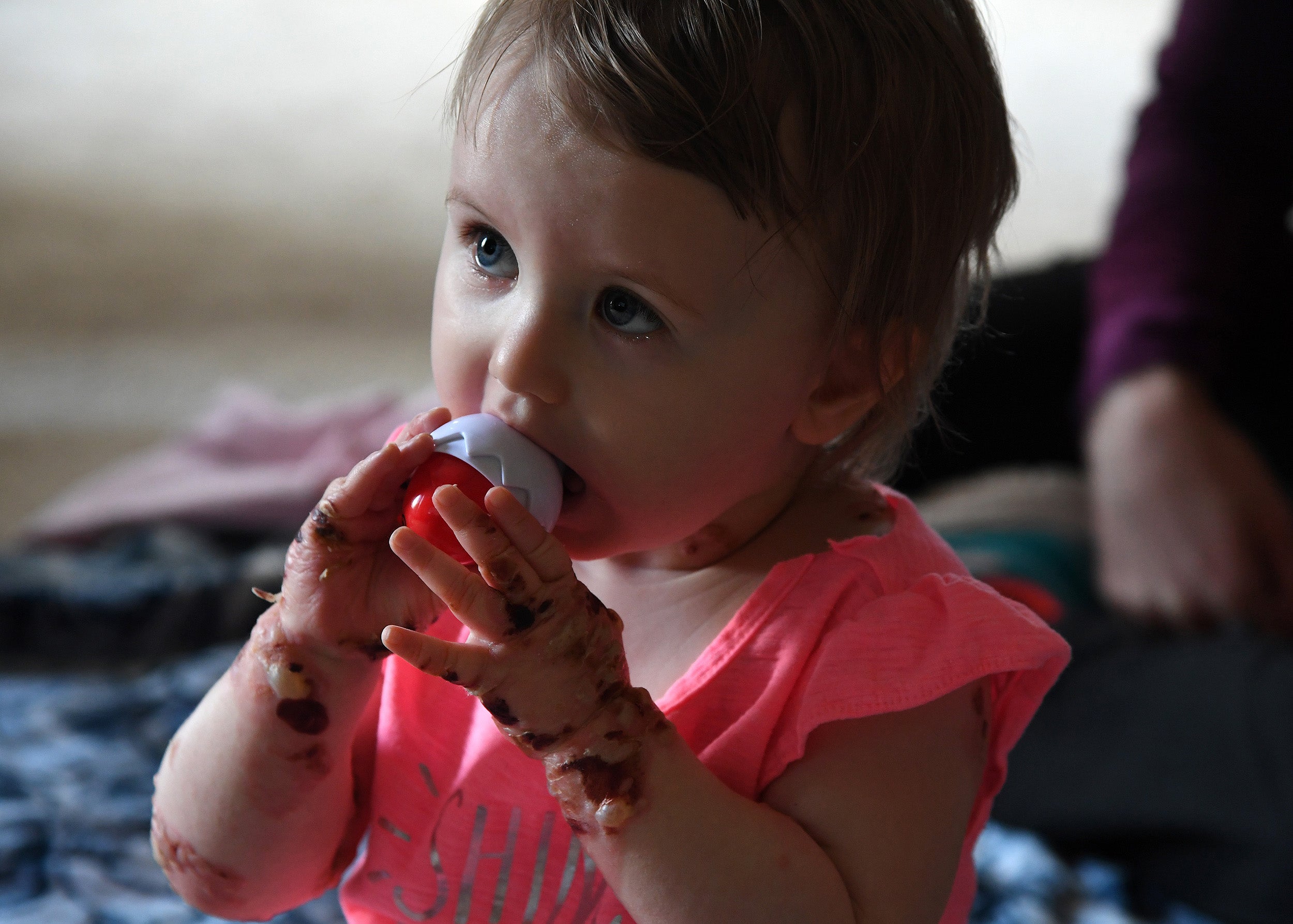
Your support helps us to tell the story
From reproductive rights to climate change to Big Tech, The Independent is on the ground when the story is developing. Whether it's investigating the financials of Elon Musk's pro-Trump PAC or producing our latest documentary, 'The A Word', which shines a light on the American women fighting for reproductive rights, we know how important it is to parse out the facts from the messaging.
At such a critical moment in US history, we need reporters on the ground. Your donation allows us to keep sending journalists to speak to both sides of the story.
The Independent is trusted by Americans across the entire political spectrum. And unlike many other quality news outlets, we choose not to lock Americans out of our reporting and analysis with paywalls. We believe quality journalism should be available to everyone, paid for by those who can afford it.
Your support makes all the difference.Every morning, Kevin Federici pulls on a head lamp, sterilises a sewing needle and prepares to prick his baby girl all over her tiny body.
She fights him with everything she has, kicking, screaming, writhing as Kevin’s mother-in-law tries to hold her granddaughter still. This process can take three hours, sometimes four or five.
And seven hours after it ends, Kevin’s wife, Heather, begins it again. Crying as her baby cries. Desperate not to cause more damage to a body already covered in blisters and wounds.
It seems like torture. But this is treatment. And for a little girl born with “the worst disease you’ve never heard of”, it’s the only one available.
Baby Elizabeth was a long time coming. Kevin and Heather met in the army in 1997. They married seven years later. Both left the military for national security careers and were intent on getting their financial ducks in a row before having kids. And even when they were ready, a baby didn’t show up right away, so they travelled the world running marathons. But after one long run near their suburban Baltimore home in 2015, Heather felt especially queasy – and then elated as a second pink line materialised on the stick of her pregnancy test.
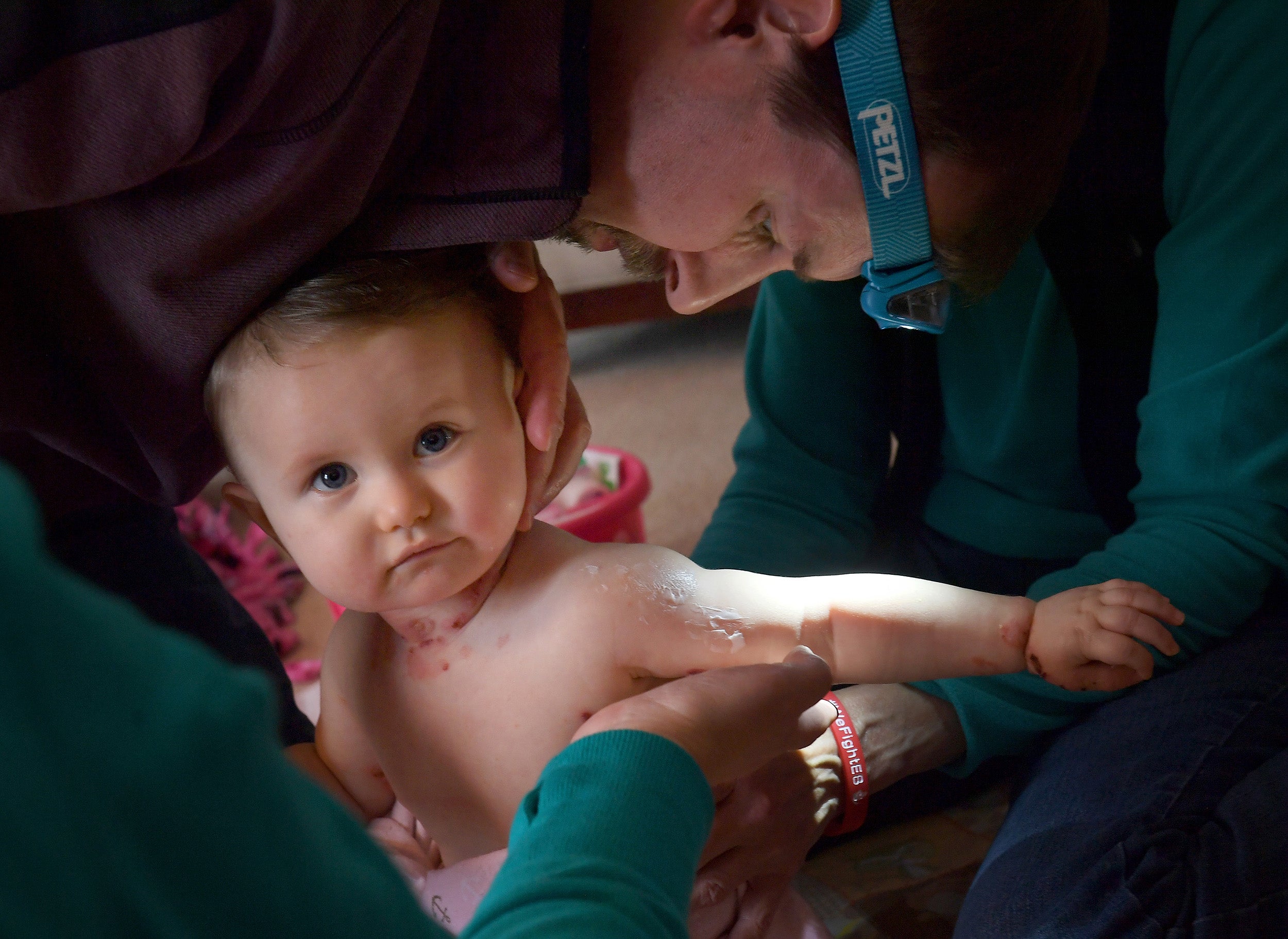
In March 2016, after 40 uncomfortable weeks, Heather felt her first contraction. Kevin met her at the hospital. Nine hours and four pushes later, their daughter was born. She had a round face, strong lungs and, as the nurses quickly discovered, no skin on the tops of her feet.
Soon there were 10 people in the delivery room. Someone was on the phone with the Centres for Disease Control and Prevention. As Heather lay in bed, doctors asked her again and again whether she had herpes. “No,” she told them. “No.”
Doctors consulted with a paediatric dermatologist, who offered a diagnosis: epidermolysis bullosa (EB). Babies born with EB are often referred to as “butterfly children”, because their skin is as fragile as a butterfly’s wings. One nurse, changing Elizabeth’s nappy, wiped the skin off her bottom. Another gave the baby a pacifier that ripped off the skin around her mouth. Open wound. Open wound.
Nine days after Elizabeth’s birth, Kevin and Heather were sent home with a pack of nappies, bandage supplies and a baby they were scared to touch.
“Why are they letting us bring her home?” Heather remembers thinking. “We didn’t know how to take care of her. We didn’t know what to do.”
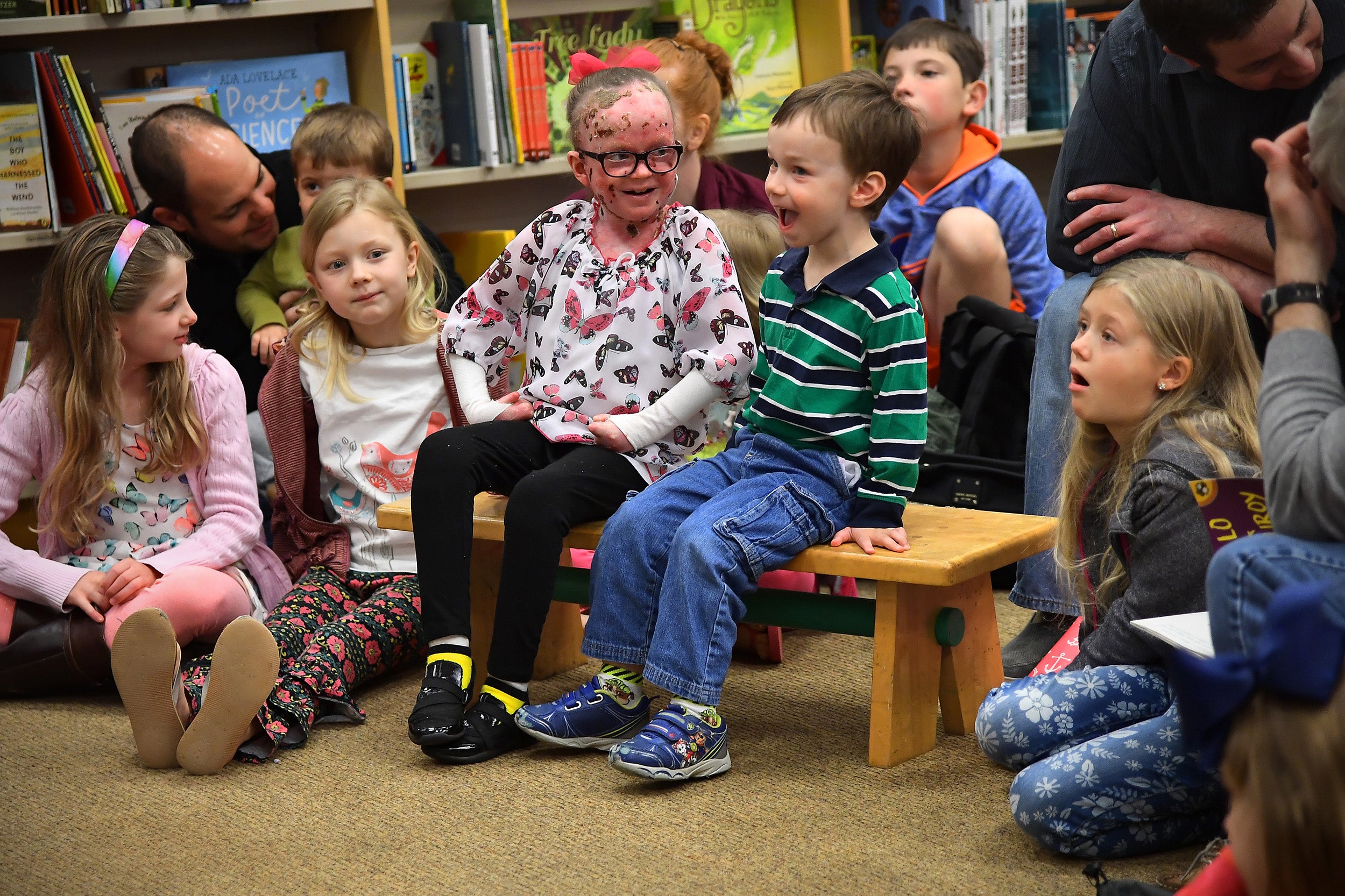
I knew Heather when we were teenagers. We worked together selling popcorn at a cinema in rural western New York. I’d tracked her life on Facebook, happy to see that she’d fallen in love with both a nice-looking man and a nice-looking dog. That they’d done well enough to buy an Eldersburg, Maryland, home with an in-ground pool, a goldfish pond and a nursery they painted the colour of the sea.
But when Heather posted a picture of 10-week-old Elizabeth, it took my breath away. Her skin was covered in so many lesions, I thought she’d been in a fire. Then I read through Heather’s previous posts until I found her short explanation that Elizabeth had been born with a rare genetic condition that causes her skin to blister at the lightest touch. I spent the rest of the day reading about EB and sent Heather a note asking whether I could come for a visit.
Driving to their home last summer, I remembered the Heather I’d known 20 years earlier: hard-working, generous, goofy and ebullient. When she opened the door to hug me, I was struck by the weight of her presence. It was as if the bubbles of her personality had been filled with lead, then sealed with layers of worry and exhaustion.
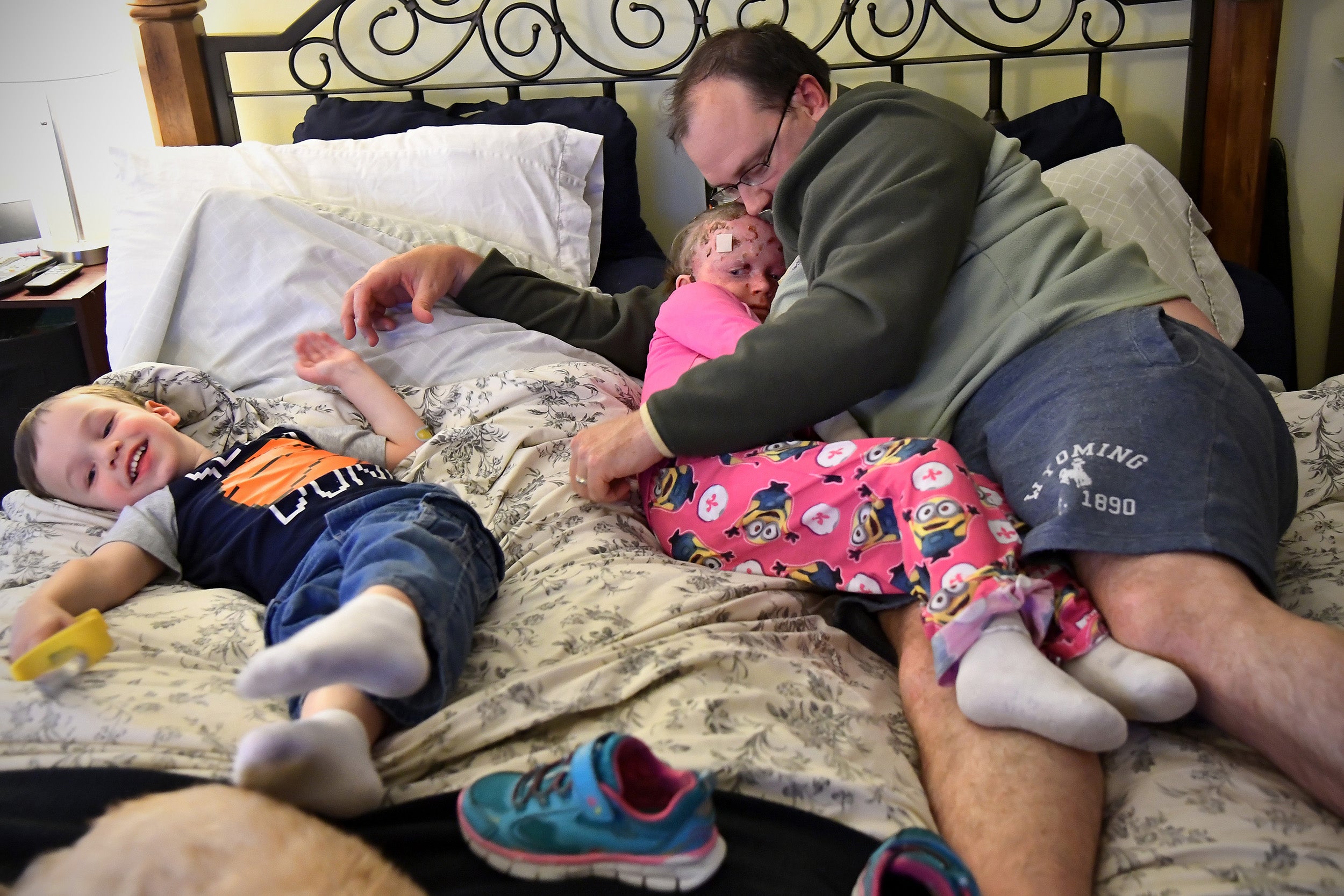
In a hushed voice, she led me to the living room. Elizabeth, propped up in a bouncy chair, wrapped in bandages, was beautiful and – like every image of human suffering – painful to look at.
A few years ago, the Dystrophic Epidermolysis Bullosa Research Association of America (DEBRA) came up with an ad campaign featuring videos of EB kids with the tagline, “It doesn’t hurt to watch”. The slogan was effective, but erroneous. It is searing to see a child in agony and parents tormented by their inability to help.
As Heather and Kevin learned the day their daughter was born, most medical professionals know almost nothing about EB. It was the folks from DEBRA, an organisation for parents of EB children, who shared useful insights. The group sent the family a giant box of supplies – the ones from the hospital were actually damaging the baby’s skin – and the director, Brett Kopelan, spoke to them by phone. Kopelan coined the phrase “the worst disease you’ve never heard of” nine years ago, when his own daughter was diagnosed. “He said, ‘It’s going to be tough,’” Kevin recalled. “So toughen up. But you’ll be able to get through it.”
That was the most solace Kopelan could offer. And Heather cried upon hearing it.
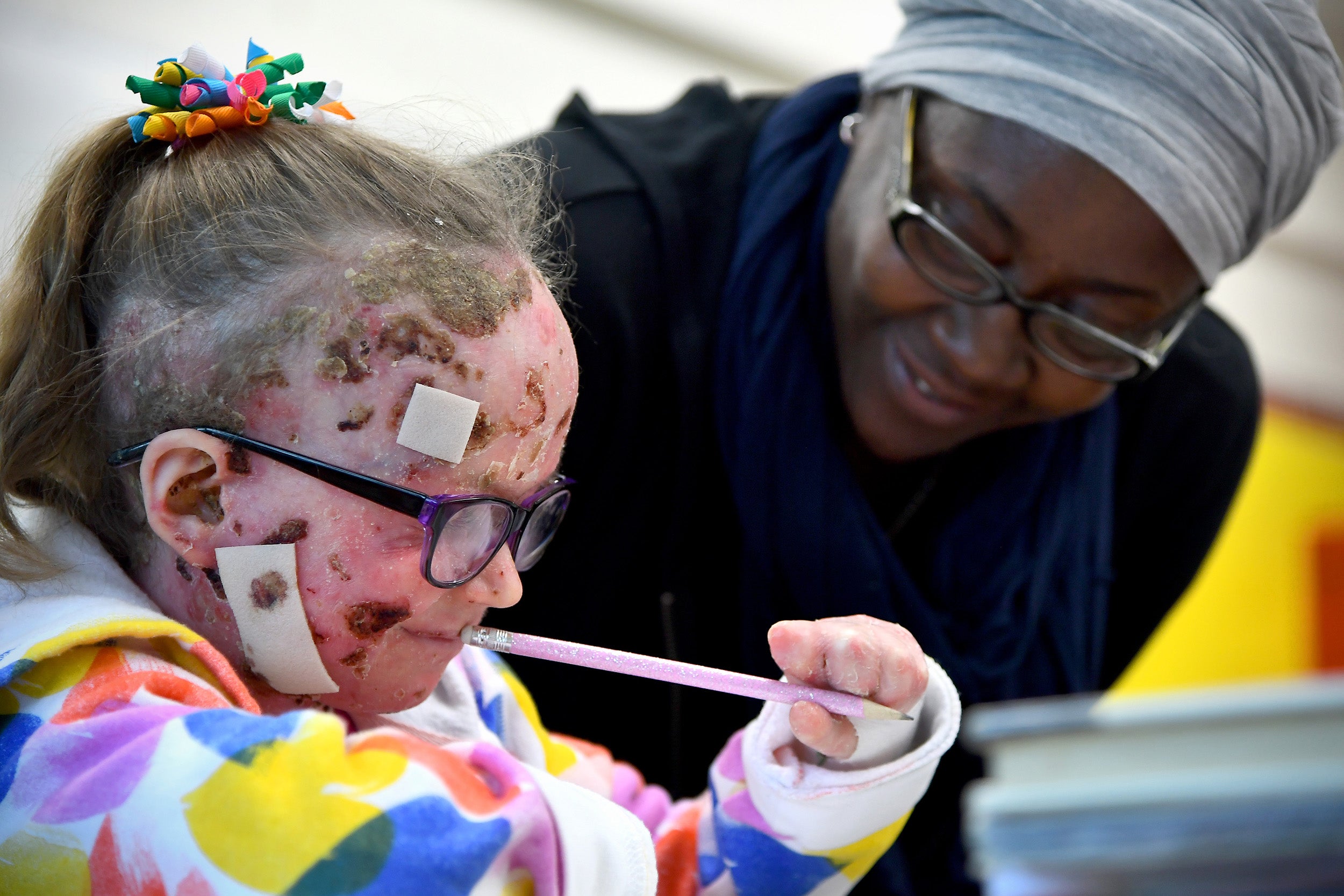
According to DEBRA, one in 20,000 people – or 200 American babies a year – are born with EB, which results when cells are missing a protein that binds the skin together. But the disease affects each patient differently. Some have extremely mild cases that they may not even be aware of, although they probably blister more easily than most after a long run. Others are born with a type so severe that they die in infancy. Another class of EB patients lead lives marked by painful whole-body scarring, fingers that fuse together, internal blistering and a propensity to develop skin cancer that kills them in their 20s or early 30s. There’s no cure for EB, only stopgap treatments. Which means, for the most part, popping blisters so they don’t expand to damage even more skin, and then wrapping the sores to prevent infection.
In the first weeks, Kevin and Heather were hopeful that Elizabeth (we are using her middle name to protect her privacy) might have a type of EB that’s easily managed. But by her second month, the blisters were spreading like a rash, consuming nearly her entire body. Anything could cause new ones: the collars of her shirts, the seams of her socks, her own hands reaching out to touch her toes.
“We just want her to hurry up and grow up,” Heather said during my first visit. That struck me as strange, until she elaborated. A -month-old can’t be persuaded not to suck her fingers or scratch an itch. A three-month-old will still need to learn how to crawl, causing fresh damage as she drags her legs across the floor.
A three-month-old can't tell her parents where it hurts, although they already know. It hurts everywhere.
Katie and Joe Murray shudder when they think about the first year. The year after their daughter Ella was born with no skin on her lower legs.
The year Joe was in law school and Katie worked full time on Capitol Hill in Washington, and every night at 10 they started the process of popping Ella’s blisters and changing her bandages, which took hours and didn’t stop their baby from waking half a dozen times a night. The year they were learning to be parents in general and parents to a sick child in particular.
“There were nights I would just lie in bed and cry,” Katie remembers. “Yes, it was all very emotional, but I was just so physically exhausted that I couldn’t function.”
Today, Ella is almost 10 and a top student in her fourth-grade class at James K Polk Elementary School in Alexandria, Virginia. She loves singing and reading and just joined the journalism club at school.
She has Recessive Dystrophic EB, one of the most severe forms of the disease. Ella’s feet are webbed and her fingers are fused together by the scar tissue from incessant wounds. But she still has the use of her thumbs, so she can write and brush her teeth. Because she needs to consume twice as many calories as a normal kid – it takes a lot of energy to continually heal wounds – she has a supplementary feeding tube. She can walk but will never play tag on the playground.
The physical effects of EB are devastating. Ella is in near-constant pain, still driven to tears when her sores are cleaned and redressed. She has surgery once a year to widen her esophagus, because EB blisters also form inside the body, creating scars that make it difficult to swallow. Eventually, her thumbs will fuse to her hands, requiring more surgery to separate them.
But the social effects are almost worse. The kids at school are used to Ella’s scarred face and bandaged arms. But at grocery stores, she’s an oddity. And she never wants to attend another party at Chuck E Cheese. “She spends her whole time surrounded by kids who are staring and making comments,” says Katie. “It’s not fun.”
Katie is pregnant with her third child, and as with their second, the Murrays have used fertility medicine and genetic testing that gave them a 98.5 per cent guarantee that the baby won’t have EB. But in her most honest moments, Ella will admit that she almost hopes that her new sibling will have it. Just so she won’t be so alone.
“What do you say to that?” Joe shrugs. “You know, I get it.”
Last June, Elizabeth’s genetic tests came back, showing that she has EB Simplex, Generalised Severe. This type of EB is bad, but not nearly as bad as Ella’s. Because Elizabeth’s EB affects an upper layer of skin, she will heal without scarring, her fingers won’t fuse together, and she should have a normal life expectancy.
That day, Heather and Kevin cried with relief. Three months later, they got the results of their own genetic testing, to see which of them was the carrier. The answer was neither.
Elizabeth’s EB was caused by a fluke genetic mutation. It could happen to anyone. But it seldom does.
“It just hit me very hard,” Heather said. “Because I thought, ‘Man, what are the chances of that?’”
After Elizabeth’s birth, Heather's newly-retired mother, Val Whalen, left western New York and moved in to help.
Heather thought that motherhood would be full of long runs with the pushchair and scenes of her dog and baby snuggled together. Instead, the dog had to be sent off to live with Kevin’s mother, and all of Heather’s waking minutes seemed to be spent working, puncturing blisters or wrangling insurance companies. Wound-care supplies alone can cost $1,000 a month, and the Federicis switched insurers twice before enrolling with one that would pay 70 per cent of the cost.
Last July, they got a break and learned that the EB Centre at Cincinnati Children’s Hospital, one of the few EB clinics in the country, had taken them off the long waiting list for an appointment.
They hoped that the doctors would offer “advice and guidance that would help us take care of her,” Kevin said after the appointment. What they heard instead was, “Keep doing what you're doing.”
Anne Lucky, the paediatric dermatologist who runs the clinic, understands the couple’s frustration. Until the past decade, there was little advanced research being done on EB treatment. Today, there are promising gene and protein therapies on the horizon, but these are still in clinical trials.
Patients come from all over the world, Lucky says, and “we tell them ahead of time that we don’t have a cure. We tell them we do everything we can to make life as normal as possible.”
A large part of what the clinic does is lobby insurance companies to provide daily nursing visits to families with EB children. “It’s very hard to inflict pain on your child every day,” Lucky says. So if a nurse can do wound care, then Mum and Dad can just be Mum and Dad.
Because of Maryland’s nursing shortage, the Federicis have only been able to get an in-home nurse to visit once a week, and she doesn’t change bandages.
On weekends, Kevin and Heather are on the floor together, Kevin with the needle, Heather trying to keep Elizabeth steady while Sesame Street plays in the background.
In her first few months, Elizabeth tolerated the procedure fairly well. But as the months ticked on, she began to fight back, her raspy voice calling out in protest.
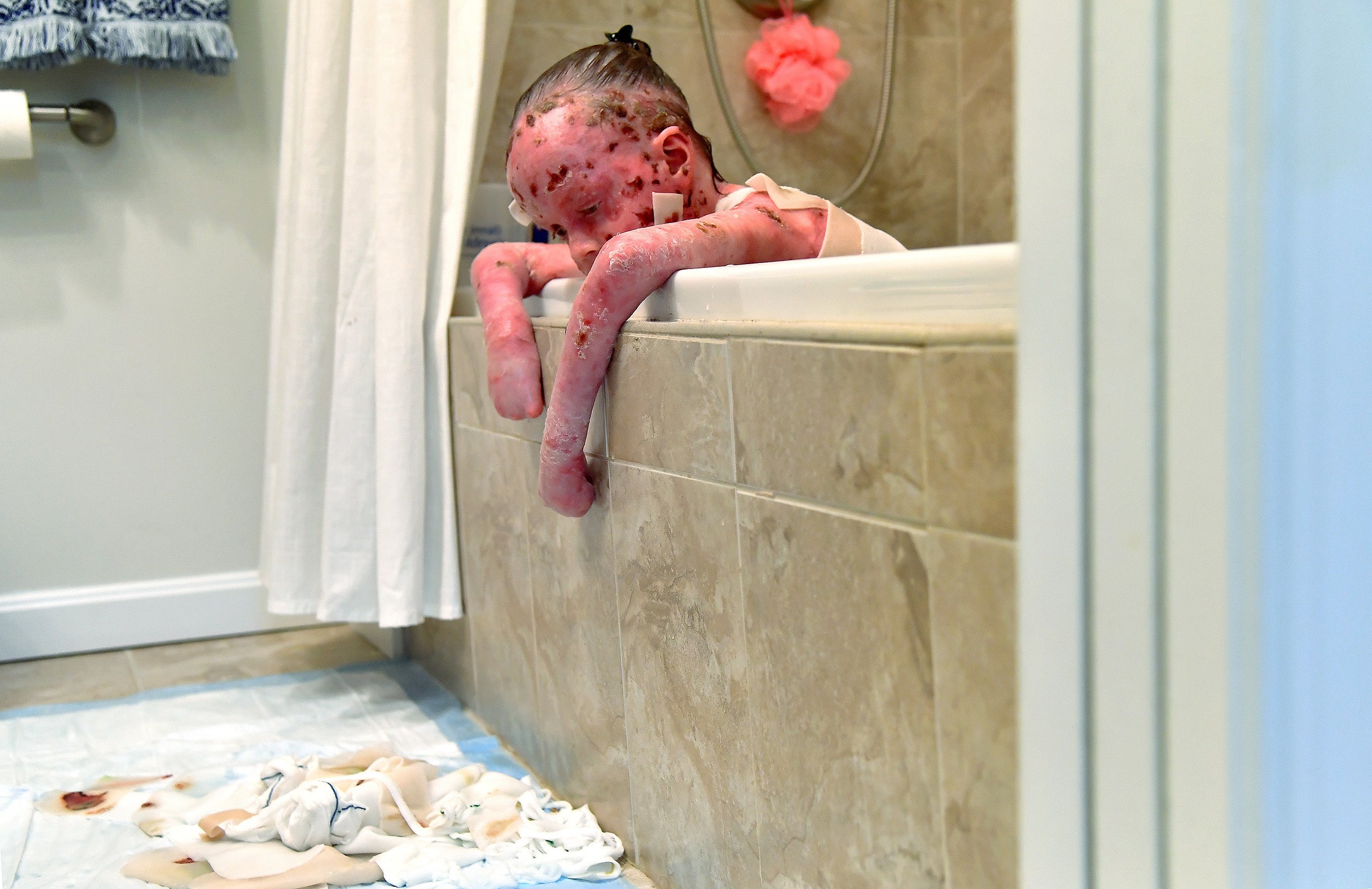
“Even now,” Heather said, “if Kevin is trying to pop a blister on her foot and he tells me to hold her leg, I don’t like to hold her leg, because if I’m holding it hard I don't know if it’s going to make her skin come off.”
The only way to help her is to hurt her. It's a reality that ravages them.
By the winter, Elizabeth’s skin looked greatly improved. Someone meeting her might not have noticed her blisters at first.
Kevin and Heather weren’t entirely sure what caused the improvement. It could have been the new ointment they were using as part of a clinical trial, or the cool weather. (They’d learned the hard way that Elizabeth’s skin breaks out in temperatures above 22C.) Or it’s possible that her skin was learning to compensate for the protein it lacks, as they’d heard can happen with Elizabeth’s type of EB.
But even as things appeared outwardly better, they were actually becoming more challenging. Elizabeth was eating solids, which meant that she was producing firmer bowel movements that damaged the skin of her bottom. The initial sore caused by her first diaper change had refused to heal, and a nagging infection set in. She developed a blister in the white of her eye. And the bandage change routine was taking longer than ever. Kevin missed a couple of hours of work every morning to do the first round, while Heather rushed to her office by 6am. Then she’d leave to be home by 4:30pm so that she and Val could begin popping blisters again. On a good day, they might be able to put Elizabeth to bed by 8:30 and then start making dinner at 9pm.
“Half the time I don’t even want to eat,” Heather said. “I just want to go to sleep.” But she knows that won’t happen, because Elizabeth, itchy and uncomfortable, is up five or six times a night and needs to be soothed so she won’t scratch herself.
Kevin, private by nature, never mentioned Elizabeth’s condition to his colleagues. And when co-workers asked Heather about the baby, she’d say, “‘Oh, fine.’ And then I’d walk away. And then I’d cry.”
Elizabeth wore a pink crown and a shamrock bib for her first birthday. She wasn’t sure what to make of her Cookie Monster cake but found that she shared her favourite monster’s love of chocolate chip cookies.
She has fine, straight hair, grey-blue eyes and a nose that crinkles when she smiles. Which is often. “She wakes up visibly happy every single day,” Heather says. She loves wagon rides, snuggles, rice snacks and her grammy. In her 13th month, she started trying to stand. She is getting big, just as her parents wanted.
I ask Kevin and Heather if, after a year, they feel any more optimistic about life with EB. Kevin suspects that the summer will be tough, but overall, he says, “I think it’s going to get better.”
“I’m scared,” Heather says. “I’m scared of infection. I’m scared that people are going to be mean to her. I’m scared that it’s going to ruin her life.”
Then I ask if, a year later, they feel more optimistic about life with Elizabeth, who’s now not just an infant with a disease, but the cuddly, giggling little girl they love.
“Of course,” Heather says, her eyes filling with tears. “She’s just so beautiful.”
© Washington Post
Join our commenting forum
Join thought-provoking conversations, follow other Independent readers and see their replies
Comments